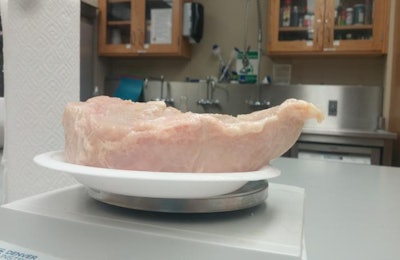
A majority of farmers are not yet changing their growing practices to address breast meat conditions like woody breast, according to new survey data.
As part of the quarterly WATT/Rennier Poultry Confidence Index survey, WATT Global Media is asking additional questions about the state of the industry as well as emerging trends, technologies and challenges. This blog post reflects the results of supplemental questions included in the August 2018 quarter three survey. The next installment of Dr. Greg Rennier’s column reflecting the results of this most-recent quarter’s survey will be published in the October 2018 issue of WATT PoultryUSA.
Woody breast and white striping
Breast meat myopathies like woody breast and white striping continue to be troublesome for the chicken industry. To further complicate matters, the cause of those conditions is somewhat mysterious. Researchers and breeders are looking into the matter to resolve the situation, which doesn’t present a food safety risk but does create a marketing problem.
The conditions could be related to the elevated growth rates of the modern broiler bird. Some see slowing down growth as a potential solution. Others see a link between the bird’s nutrition, feeding plan and growing conditions and the disorders. In the future, a holistic approach may be needed to solve the problem. According to survey results, only a minority are making changes at the farm level to address the issue.
When asked, “Have you changed your bird feeding or growing program to reduce the incidence of woody breast or white striping in your birds?”
- 67.4 percent responded, “No.”
- 21.1 percent responded, “It’s being considered but it’s not decided.”
- 11.6 percent responded, “Yes.”
When asked to select a statement that most closely covers their approach to controlling the incidences of woody breast and white striping:
- 47.1 percent responded, “Nothing, this is not a concern for us.”
- 24.1 percent responded, “Nothing, we don’t grow big birds.”
- 19.5 percent responded, “We’ve changed our feed formulation.”
- 10.3 percent responded, “We’ve reduced the size of the birds.”
- 4.6 percent responded, “We’ve changed breeds.”
Automated catching
As consumers grow more concerned with animal welfare and the labor market becomes more competitive, the use of machinery to catch broilers in the house could become more appealing to the poultry industry.
The machinery is able to reduce the need for laborers to do the work of catching birds and putting them into transport modules and can enhance animal welfare outcomes. Experts agree the most challenging part of the bird’s life, from an animal welfare standpoint, is the period between catching and slaughter. However, survey responses show the machinery is not yet making a significant impact in the industry.
When asked, “Which statement best reflects your experience with automated poultry catching?”
- 62.9 percent responded, “We are not using automated systems and we are not considering it.”
- 25.8 percent responded, “We are not currently using automated systems but we are considering it.”
- 11.2 percent responded, “We are currently using automated catching systems.”
When asked to select a statement that best reflects their position toward automated catching systems:
- 39.3 percent responded, “We are not using automated catching systems because they are not proven to outperform human catch crews.”
- 34.5 percent responded, “We are not using automated catching systems because labor is available and the quality of their work is high.”
- 14.3 percent responded, “We are not using automated catching systems because the expense is too great.”
- 11.9 percent responded, “We are currently using automated catching systems, or considering them, due to the potential labor savings and the shortage of labor for catching birds.”
- 7.1 percent responded, “We are currently using automated catching systems, or considering using them, because of elevated animal welfare conditions.”
- 6 percent responded, “We are currently using automated catching systems, or considering using them, because of potential greater efficiency than a conventional catch crew.”

















